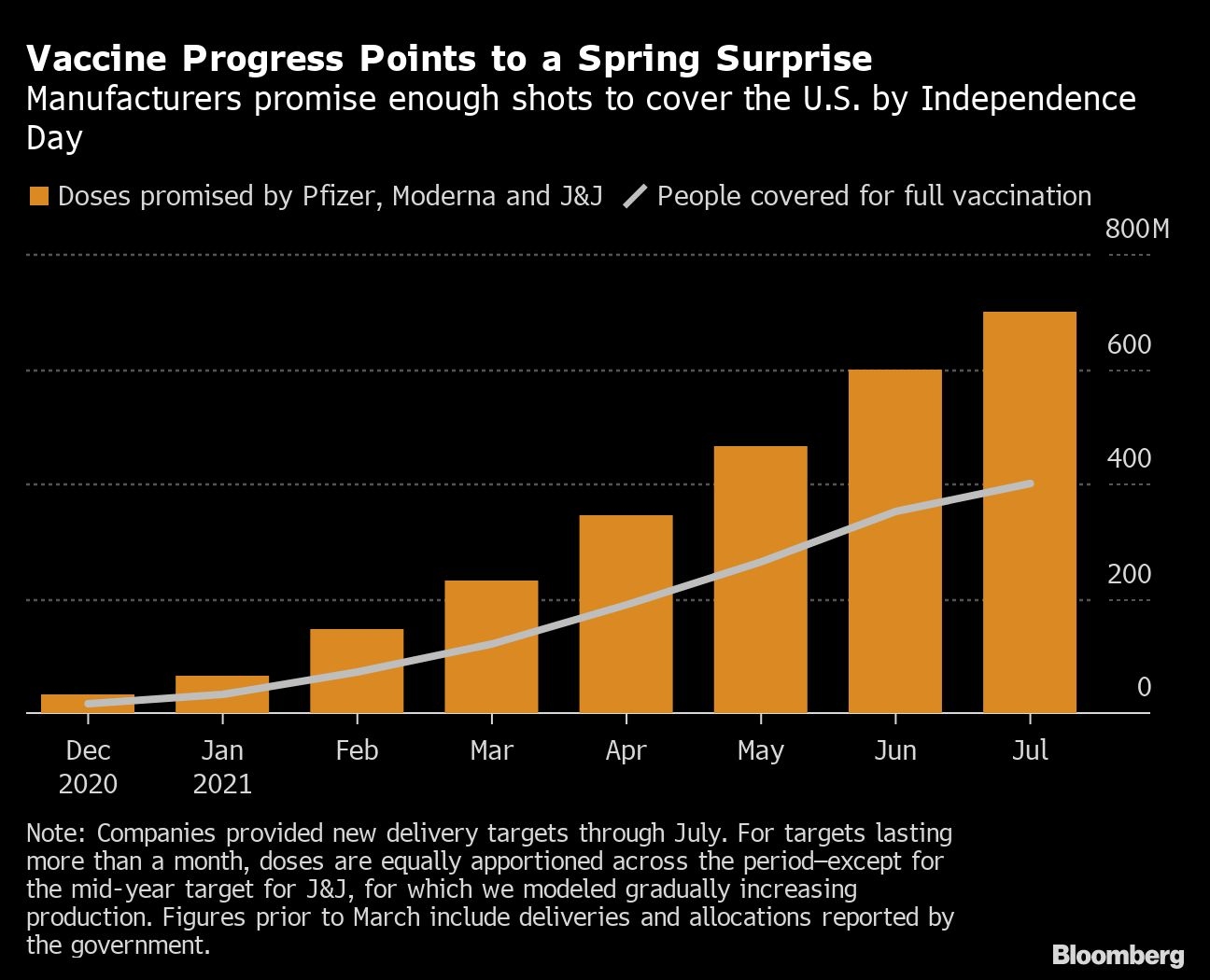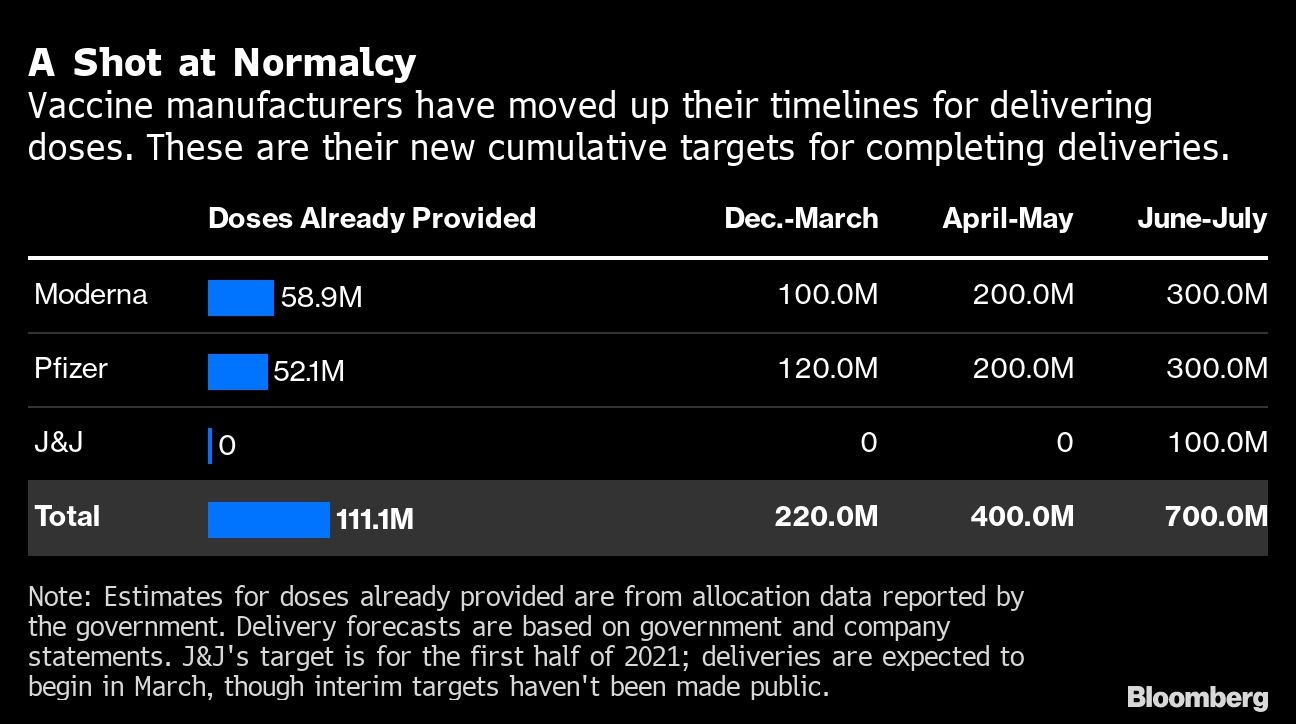Feb 18, 2021
A U.S. vaccine surge is coming, with millions of doses promised
, Bloomberg News
New COVID-19 variants could lead to subsequent vaccinations: Healthcare strategist
The U.S. vaccine supply is poised to double in the coming weeks and months, according to an analysis by Bloomberg, allowing a broad expansion of doses administered across the country.
Currently, the U.S. is administering 1.6 million doses a day, constrained by the recent supply of about 10 million to 15 million doses a week. But COVID-19 vaccine manufacturers and U.S. officials have accelerated their production timelines and signaled that the spigots are about to open, providing hundreds of millions of doses to match the growing capacity to immunize people at pharmacies and mass-vaccination sites.
A review of drugmakers’ public statements and their supply deals suggests that the number of vaccines delivered should rise to almost 20 million a week in March, more than 25 million a week in April and May, and over 30 million a week June. By summer, it would be enough to give 4.5 million shots a day.
Bloomberg’s analysis is based on company and government statements, data on the number of shots already delivered and conversations with people familiar with the manufacturing effort who spoke on condition of anonymity. The analysis assumes drugmakers will meet their new delivery targets — not a guarantee in a year-old pandemic where much has gone wrong.

Pfizer Inc. and Moderna Inc. have promised to deliver more than 500 million additional doses by the end of July, and Johnson & Johnson is expected to deliver 100 million doses of its one-shot vaccine by the end of June. Taken together, that’s enough to vaccinate 400 million people — more than is needed to cover all of the U.S. — before the end of July.
Additional details from the companies make it possible to model their deliveries more precisely. Pfizer has said it will have shipped 120 million doses by the end of March — more than 10 million a week from now until then. Moderna this week said it would deliver 30 million to 35 million doses a month in February and March, and 40 million to 50 million a month after that. Because of differences in how doses are manufactured and then made available, Bloomberg’s projections may not exactly match when doses will be or have been delivered.
“What we are going to see is every week a continued ramp,” said Andy Slavitt, White House senior adviser for COVID response. By the end of March, he said, there should be 200 million doses available for distribution to states — about 90 million more than the current total, according to U.S. figures.
“That implies there will be a whole lot more than there are today,” Slavitt said during in an online interview with the Washington Post Thursday.
Drugmakers have missed some previous projections following scientific setbacks and manufacturing failures. To mitigate those risks, the U.S. reached agreements to buy at least 1.21 billion doses, far more than what’s needed to cover all Americans.
Even if the promised doses are delivered, the U.S. would face a daunting logistical challenge of administering them, and President Joe Biden’s administration has remained conservative in its own projections. On Wednesday, Jeff Zeints, White House coronavirus response coordinator, said the government hoped to have enough vaccines to cover 300 million Americans by the end of July — about 100 million people less and a month later than what Bloomberg’s analysis indicates is coming.
“There are opportunities for things to go better, but like this week's weather proves, there are surprises in store as well,” Slavitt said, referring to winter storms that have slowed vaccination efforts across the country.
Administration officials including Zeints as well as Biden’s chief medical adviser, Anthony Fauci, have also talked down J&J’s expected production, saying they expect it to be backloaded toward the summer.
In a statement this week, J&J said it “intends to distribute vaccine to the U.S. government immediately following authorization, and expects to supply 100 million doses to the U.S. in the first half of 2021.”

In the meantime, expectations of an increasing amount of vaccine are being matched by an expanding on-the-ground capacity to get it into arms.
The Federal Emergency Management Agency has been preparing mass-vaccination centers, such as a temporary site in Delaware that aims to perform 18,000 vaccinations over a week. Around the country, the federal government has begun to gradually feed vaccine doses to pharmacies — with 6,500 locations so far — to start giving shots to the broader public. In early January the White House said it would allow retired nurses and doctors to return to work to help administer vaccines.
“We need to increase the number of places where people can get vaccinated, and also at the same time increase the number of vaccinators,” Zeints said on Jan. 27, describing the program for retired health workers.
States have made clear they are ready for more doses than they are currently getting. Michigan’s top health official said early this month that the state could perform 80,000 vaccinations a day — at least 30,000 more than its recent daily average. In California, officials are opening sites like the San Francisco 49ers football stadium, where they will be able to perform 15,000 doses a day.
In New York City, Mayor Bill de Blasio said the city had delayed opening several mass-vaccination sites while waiting for doses.
“We have the infrastructure in place to deliver half a million doses per week. All that’s missing is the supply to get it done,” de Blasio said in a statement Wednesday.
The story of the COVID-19 pandemic has been frustration and disappointment, and one lesson the Biden administration may have learned from the previous occupants of the White House is that there’s little upside in over-promising and under-delivering.
Biden came into office targeting 100 million doses in 100 days, a daily rate that was achieved 72 hours after he was sworn in on Jan. 20 (the U.S. has administered 57.4 million doses as of Wednesday, according to the Bloomberg Vaccine Tracker). His administration has benefitted from the vaccine programs started under the Trump administration to develop and buy the shots. And while Biden White House officials have often talked-down the handoff of the program, much of the manufacturing and delivery momentum was created months before Biden took office.
In New Jersey, the state has given first doses to 1.07 million people as of Wednesday. Commissioner of Health Judith Persichilli said at a briefing Wednesday that the state has another 2.5 million people in line, ready to get the shots.
“With the number of points of dispensing in New Jersey, we could easily get up to three-and-a-half million people vaccinated in a short period of time,” said Persichilli, “if we had the vaccine.”










